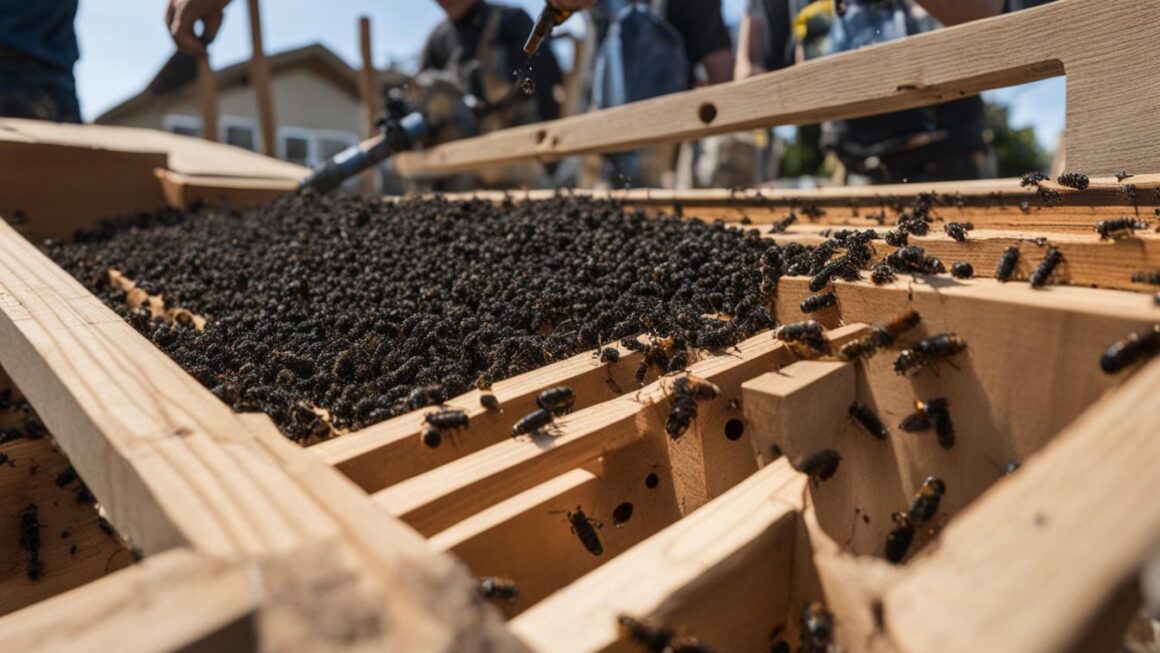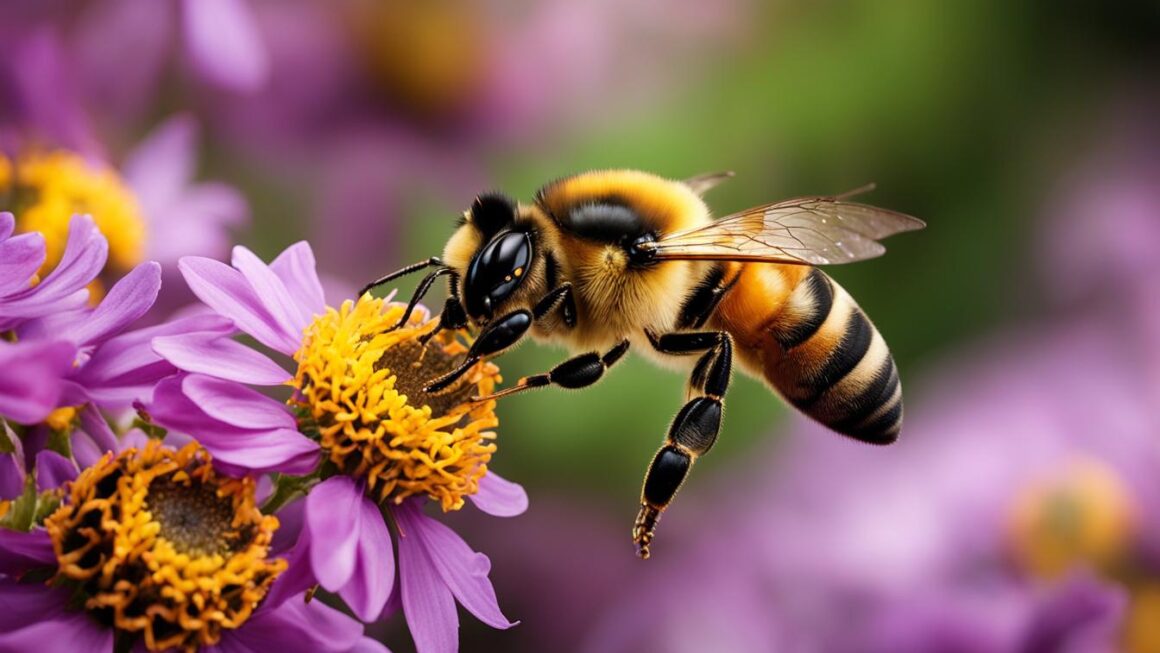If you’re dealing with carpenter bees, you know how destructive these insects can be to wooden structures. Their drilling and nesting habits can cause significant damage and compromise the integrity of your home. It’s important to take immediate action to remove these pests and prevent further infestation. In this article, we will explore proven methods for carpenter bee removal and pest control.
Key Takeaways:
- Identify carpenter bees by their size and appearance, including their larger size compared to bumblebees and shiny, hairless abdomens.
- Look for signs of carpenter bee damage, such as circular openings in wood, sawdust or wood shavings near the openings, and stains from bee excrement.
- Carpenter bees damage wood by drilling tunnels and nesting galleries, which can weaken structures if left untreated.
- Natural methods for carpenter bee removal include citrus fruit sprays, almond oil sprays, loud music or vibrations, and physical barriers like fine mesh screens.
- Pesticides can be effective in eliminating carpenter bees, but it’s important to choose products that are specifically designed for these pests and follow safety precautions.
How to Identify Carpenter Bees and Carpenter Bee Damage
Carpenter bees can be easily identified by their size and appearance. They are larger than bumblebees, typically measuring around 1 inch in length. One key characteristic is their shiny and hairless abdomens, which distinguish them from other bee species.
When it comes to identifying carpenter bee damage, there are a few telltale signs to look out for. Circular openings in wood, about the size of a dime, are a common indication of their presence. These openings serve as entry points for the bees as they create tunnels and nesting galleries within the wood. You may also notice piles of sawdust or wood shavings near these openings, as carpenter bees push out the excavated material. Additionally, staining on the wood caused by bee excrement can also be observed.
In summary, to identify carpenter bees, look for their larger size and shiny, hairless abdomens. To spot carpenter bee damage, keep an eye out for circular openings in wood, sawdust or wood shavings near the openings, and stains from bee excrement.
| Identification | Damage |
|---|---|
| Carpenter bee appearance | Circular openings in wood |
| Size larger than bumblebees | Sawdust or wood shavings near openings |
| Shiny, hairless abdomens | Stains from bee excrement on wood |
How Carpenter Bees Damage Wood
Carpenter bees are notorious for causing damage to wooden structures. They have a unique behavior of drilling tunnels and nesting galleries within the wood, which can lead to significant structural damage over time. Understanding how these bees damage wood is crucial in implementing effective pest control measures.
When carpenter bees infest a wooden structure, they bore perfectly round entrances into the wood, usually around half an inch in diameter. These entrances serve as the starting point for their tunnels, which can extend several feet into the wood. As the bees excavate the tunnels, they create a network of galleries where they lay their eggs and raise their young. The constant tunneling weakens the wood, compromising its strength and integrity.
One of the challenges with carpenter bee damage is that it can often go unnoticed until it’s too late. The bees typically plug the entrances to their tunnels with wood shavings and debris, making it difficult to detect the extent of the damage. Additionally, the accumulation of bee excrement and stains on the wood surface can be an indication of a carpenter bee infestation.
| Signs of Carpenter Bee Damage |
|---|
| Perfectly round entrances in the wood |
| Wood shavings or sawdust near the entrances |
| Stains on the wood from bee excrement |
| Weakened or damaged wood structure |
Table: Signs of Carpenter Bee Damage
It’s important to address carpenter bee damage promptly to prevent further deterioration of the affected wood. If left untreated, the weakened wood can attract woodpeckers, who may further damage the structure as they search for carpenter bee larvae to feed on.
Preventing Carpenter Bee Damage
Implementing preventive measures is key to protecting wood from carpenter bee damage. Here are some effective strategies:
- Paint or varnish exposed wood surfaces to make them less attractive to bees.
- Use pressure-treated wood for outdoor structures, as it is less susceptible to carpenter bee infestations.
- Cover openings in the wood with mesh screens or caulk to prevent bees from accessing the interior.
- Regularly inspect and address any existing holes or damage to prevent reinfestation.
By taking proactive steps to protect wood from carpenter bees, you can minimize the risk of structural damage and maintain the integrity of your wooden structures.
How to Get Rid of Carpenter Bees Naturally
Carpenter bees can be a nuisance, but there are natural methods you can use to effectively get rid of them without resorting to toxic chemicals. These non-toxic methods are not only environmentally friendly, but they can also be just as effective in repelling or eliminating carpenter bees.
One natural method for carpenter bee removal is using citrus fruit sprays. Carpenter bees are repelled by the scent of citrus, so spraying a mixture of citrus fruit juice or essential oils around the affected areas can deter them from nesting or flying near your wooden structures.
Another effective natural remedy is almond oil spray. Carpenter bees are known to dislike the scent of almond oil, so spraying a mixture of almond extract and water on the wooden surfaces can be an effective deterrent. It is important to reapply these sprays regularly, especially after rain or heavy moisture, to maintain their effectiveness.
| Natural Methods for Carpenter Bee Removal |
|---|
| Citrus fruit sprays |
| Almond oil spray |
| Loud music or vibrations |
| Physical barriers like mesh screens |
In addition to sprays, you can also use loud music or vibrations to deter carpenter bees. These pests are sensitive to loud noises and vibrations, so playing music or using devices that emit vibrations near the affected areas can disturb and discourage them from nesting.
Lastly, physical barriers such as fine mesh screens can be used to prevent carpenter bees from accessing wooden structures. Install these screens over existing holes or potential nesting sites to create a barrier that prevents carpenter bees from entering. Ensure that the mesh size is small enough to keep carpenter bees out while still allowing proper airflow.
By utilizing these natural methods, you can effectively control carpenter bee populations and protect your wooden structures without resorting to toxic chemicals. However, it’s important to note that severe infestations may require professional intervention. If natural methods prove ineffective, consider seeking the assistance of pest control professionals who can provide targeted treatments to eliminate carpenter bees and prevent further damage.
Carpenter Bee Pesticides
Understanding Effective Insecticides for Carpenter Bee Control
Carpenter bees can cause significant damage to wooden structures, making it crucial to implement effective pest control measures. One method to eliminate these pests is by using carpenter bee pesticides. These insecticides are specifically designed to target and eradicate carpenter bees, ensuring the protection of your home and property.
When choosing a carpenter bee pesticide, it is important to select one that is potent against these specific insects. Look for products containing active ingredients such as cyfluthrin, permethrin, or carbaryl, as these chemicals have proven to be highly effective in eliminating carpenter bees.
Using carpenter bee pesticides can be a highly efficient way to control and eradicate these destructive pests. However, it is essential to follow the instructions provided by the manufacturer to ensure the safe and effective use of the insecticide.
It is recommended to apply carpenter bee pesticides directly into the bee holes to ensure maximum effect. This allows the insecticide to reach the nesting galleries, where the bees reside. Additionally, insecticidal dusts can be applied deeper into the wood to prevent further infestation, providing long-lasting protection against carpenter bees.
| Pesticide | Main Ingredient | Application Method | Effectiveness |
|---|---|---|---|
| Product A | Cyfluthrin | Direct spray into bee holes | High |
| Product B | Permethrin | Direct spray into bee holes | Medium |
| Product C | Carbaryl | Insecticidal dust application | High |
It is important to note that when using carpenter bee pesticides, safety precautions should be taken. Always wear protective clothing, including gloves and a mask, to minimize exposure to the chemicals. Keep children and pets away from treated areas until the pesticide has dried completely.
By utilizing carpenter bee pesticides in combination with other pest control methods, such as natural deterrents and preventive measures, you can effectively eliminate carpenter bees and safeguard your wooden structures from further damage.
How to Prevent Carpenter Bee Infestations
Carpenter bees can be a nuisance and cause damage to wooden structures. To protect your home from these pests, it is important to implement preventive measures and create an environment that is less attractive to carpenter bees.
Identify and Seal Potential Entry Points
Inspect your property for any cracks, crevices, or gaps in the wood that could serve as entry points for carpenter bees. Seal these openings with caulk or wood putty to prevent bees from nesting inside. Additionally, ensure that windows, doors, and screens are properly fitted and do not have any gaps that bees can use to enter your home.
Apply a Protective Coating to Wooden Surfaces
Carpenter bees are attracted to bare and untreated wood. Applying a protective coating such as paint or varnish to wooden surfaces can make them less appealing to the bees. Choose a coating that is specifically formulated to repel insects and follow the manufacturer’s instructions for application.
Use Physical Barriers
Installing fine mesh screens over openings, such as vents, can help prevent carpenter bees from gaining access. Be sure to choose a mesh size that is small enough to keep out the bees while still allowing for proper airflow. Additionally, you can use treated lumber or metal flashing to cover vulnerable areas and make them less accessible to the bees.
By taking these preventive measures, you can greatly reduce the risk of carpenter bee infestations and protect your wooden structures from damage. Remember to regularly inspect and maintain your property to address any signs of bee activity and potential vulnerabilities.

Using Carpenter Bee Traps
Carpenter bee traps are a highly effective method for trapping and eliminating carpenter bees from your property. These specially designed traps mimic bee nests, attracting carpenter bees and preventing them from escaping once inside. By using carpenter bee traps, you can significantly reduce the population of these destructive pests and protect your wooden structures.
When using carpenter bee traps, it is important to place them strategically near the bee holes or areas where carpenter bees are commonly found. The trap’s design and bait attract the bees, luring them into the trap. Once inside, they become trapped and eventually perish. Carpenter bee traps offer a non-toxic and environmentally friendly solution to control carpenter bee infestations.
A properly placed and maintained carpenter bee trap can catch numerous carpenter bees over time, which helps to reduce future infestations. It is recommended to regularly check the traps and dispose of any trapped bees. Additionally, it is important to clean and maintain the traps to ensure their effectiveness. By consistently using carpenter bee traps, you can keep your property free from carpenter bees and minimize the damage they cause.
| Carpenter Bee Trap Benefits | Carpenter Bee Trap Considerations |
|---|---|
|
|
Using carpenter bee traps alongside other preventive measures such as sealing wood surfaces and applying paint or varnish can provide comprehensive protection against carpenter bee infestations. If you are dealing with a severe infestation or if DIY methods are not effective, it is recommended to consult with pest control professionals who can provide expert advice and assistance in carpenter bee removal.

Expert Tip:
“When using carpenter bee traps, make sure to choose traps with durable materials and effective bait. Placing the traps near the bee holes and regularly maintaining them will optimize their efficacy and help prevent future infestations.”
Protecting Wood from Carpenter Bees
Carpenter bees can cause significant damage to wooden structures, making it essential to take proactive measures to protect your wood. By following these methods, you can safeguard your property from carpenter bee infestations and prevent damage:
Paint or Varnish Exposed Surfaces:
One of the most effective ways to protect wood from carpenter bees is by applying paint or varnish to exposed surfaces. The layer of paint acts as a barrier, making the wood less attractive to the bees. Be sure to cover all areas of exposed wood, paying close attention to corners, seams, and entrances where bees are most likely to target.
Use Pressure-Treated Wood:
When building or repairing outdoor structures such as decks, fences, or pergolas, consider using pressure-treated or rot-resistant wood. These types of wood are less susceptible to carpenter bee damage, as they contain natural or chemical preservatives that deter these pests.
Install Mesh Screens or Caulk:
To prevent carpenter bees from entering existing openings or creating new ones, install fine mesh screens over vents, gaps, and other potential entry points. Additionally, use caulk to seal any cracks or holes in the wood. By sealing off these areas, you can effectively block the bees’ access and reduce the risk of infestation.
By implementing these preventative measures, you can protect your wood from carpenter bees and minimize the risk of costly damage to your property.
| Methods | Effectiveness |
|---|---|
| Paint or Varnish | Highly effective |
| Pressure-Treated Wood | Very effective |
| Mesh Screens or Caulk | Effective |
Hiring Pest Control Professionals for Carpenter Bee Removal
If you’re dealing with a severe carpenter bee infestation or if your DIY methods haven’t been effective, it may be time to consider hiring pest control professionals for carpenter bee removal. Professional carpenter bee extermination services can provide you with the expertise, tools, and experience necessary to effectively eliminate these pests and prevent further damage to your property.
When you hire a professional pest control service for carpenter bee removal, you can expect a thorough assessment of the infestation and a customized treatment plan tailored to your specific needs. These professionals have in-depth knowledge of carpenter bee behavior and nesting habits, allowing them to target and eliminate the problem at its source.
Pest control professionals also have access to specialized equipment and insecticides that are highly effective against carpenter bees. They can safely apply these products to treat the affected areas and prevent future infestations. Additionally, they can provide recommendations on preventive measures to protect your wooden structures from future carpenter bee damage.
| Pest Control Professionals for Carpenter Bee Removal | Benefits |
|---|---|
| Expertise and Experience | Professionals have the knowledge and experience to effectively eliminate carpenter bees. |
| Customized Treatments | Treatment plans tailored to your specific infestation and property. |
| Specialized Equipment and Products | Pest control professionals have access to specialized equipment and effective insecticides. |
| Preventive Measures | Experts can provide recommendations on preventive measures to protect your property from future carpenter bee damage. |
When hiring pest control professionals for carpenter bee removal, it’s important to choose a reputable and licensed company. Look for professionals who have experience in dealing with carpenter bees and a track record of successful pest control services. You can also ask for recommendations from friends, neighbors, or local homeowners’ associations.
By hiring pest control professionals for carpenter bee removal, you can ensure that the infestation is effectively addressed and the damage is minimized. Their expertise and specialized treatments can provide long-term relief from carpenter bee problems, giving you peace of mind and protecting the value of your property.
Conclusion
In conclusion, effectively removing carpenter bees is crucial to prevent further damage to wooden structures. By implementing a combination of natural methods, pesticides, and preventive measures, you can eliminate these pests and protect your home.
Utilizing natural methods such as citrus fruit sprays, almond oil sprays, loud music or vibrations, and physical barriers can repel or eliminate carpenter bees in an environmentally friendly way. Additionally, the application of carpenter bee pesticides, either through sprays or insecticidal dusts, can effectively eliminate these pests.
Prevention is key in avoiding carpenter bee infestations. Sealing wood surfaces, applying paint or varnish, using mesh screens, and addressing existing holes and damage are all essential steps in protecting wooden structures from further infestation.
In cases of severe infestations or when DIY methods are not effective, hiring pest control professionals is recommended. These experts have the knowledge, tools, and experience to exterminate carpenter bees and prevent future damage to your property.
FAQ
How can I identify carpenter bees and their damage?
Carpenter bees can be identified by their larger size and shiny, hairless abdomens. The damage caused by carpenter bees includes circular openings in wood, sawdust or wood shavings near the openings, and stains on the wood from bee excrement.
What methods can be used to get rid of carpenter bees naturally?
Natural methods for carpenter bee removal include using citrus fruit sprays, almond oil sprays, loud music or vibrations, and physical barriers such as fine mesh screens. These methods are environmentally friendly and can effectively repel or eliminate carpenter bees.
How can I prevent carpenter bee infestations?
Preventing carpenter bee infestations involves sealing wood surfaces, applying paint or varnish to make them less attractive to bees, and using physical barriers such as mesh screens. It is also important to address existing holes and damage to prevent reinfestation.
Are pesticides effective for eliminating carpenter bees?
Pesticides can be used to eliminate carpenter bees. Sprays can be applied directly to the bee holes, while insecticidal dusts can be applied deeper into the wood to prevent further infestation. It is important to follow safety precautions when using pesticides and to choose products that are effective against carpenter bees.
How do carpenter bee traps work?
Carpenter bee traps resemble bee nests and can be placed near the bee holes. Once inside, the bees are unable to escape and eventually perish. Carpenter bee traps offer a non-toxic method of removal.
How can I protect wood from carpenter bees?
To protect wood from carpenter bees, it is important to paint or varnish exposed surfaces, use pressure-treated wood for outdoor structures, and cover openings with mesh screens or caulk. Regular maintenance and repairs can help prevent carpenter bee damage.
Should I hire pest control professionals for carpenter bee removal?
In cases of severe infestations or if DIY methods are not effective, it may be necessary to hire pest control professionals for carpenter bee removal. These professionals have the knowledge, tools, and experience to effectively eliminate carpenter bees and prevent further damage.




